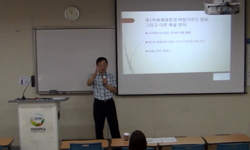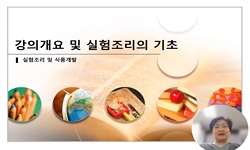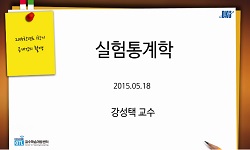Zhuxi, who epitomized the thought of neo-Confucianism, not only has an effect on Chinese idealist philosophy during the Song, Yuan, Ming and Qing dynasties,but has a direct influence on Korean social philosophy during the Korean Age. Hong Tae-Yong is ...
http://chineseinput.net/에서 pinyin(병음)방식으로 중국어를 변환할 수 있습니다.
변환된 중국어를 복사하여 사용하시면 됩니다.
- 中文 을 입력하시려면 zhongwen을 입력하시고 space를누르시면됩니다.
- 北京 을 입력하시려면 beijing을 입력하시고 space를 누르시면 됩니다.

朱熹“驗證說”萌芽與洪大容“驗證說”比較硏究 = The Comparative Study of Zhuxi's Verification Theory at the Junior Levels and Hong Dae-Yong's Verification Theory
한글로보기부가정보
다국어 초록 (Multilingual Abstract)
Zhuxi explored some problems in the field of epistemology with the theory of Ge Wu Zhi Zhi. Beyond that, he made a few opinions about verification theory and the opinions get the clearer in his old age. He was becoming more interested in natural science, and the thought about verification theory was frequently found in his later writings. In the research about natural scientific problems, he had adopted observation, experimentation and practice method. Zhuxi has opened up a new area and bends and laid the theoretical foundations for verification theory. Hong Tae-Yong carried on some theoretical results of the Zhuxi on the one hand, and made his own pragmatical learning, on the other hand. In his theory, the methodology occupied a central place. This thesis has taken the postivist theory as research objects, discusses about Hong Tae-Yong's pragmatical learning by comparing with Zhuxi's Verification Theory. He proved some opinions by the recognizing method of practice, observing methods and the recognizing method of practice. Hong Tae-Yong be divorced from Zhuxi's theory and have created a new pragmatical learning by these objective methods.
As has been described above, the main differences between the two is understanding the “Shi(实)”. Hong Tae-Yong attaches great importance to truthful information, truthful circumstances, truthful experiment and actual practice, He has made great efforts in recognizing the real things, and has verified them one by one through practice. His objective method have helped take his thought off the ZhuZi's Philosophy and have created pragmatical learning.
Zhuxi, who epitomized the thought of neo-Confucianism, not only has an effect on Chinese idealist philosophy during the Song, Yuan, Ming and Qing dynasties,but has a direct influence on Korean social philosophy during the Korean Age. Hong Tae-Yong is a well- known scholar in the later stage of the Korean Age, his theory with Zhuxi‘s became the two main schools on the Korean’s thinking.
Zhuxi explored some problems in the field of epistemology with the theory of Ge Wu Zhi Zhi. Beyond that, he made a few opinions about verification theory and the opinions get the clearer in his old age. He was becoming more interested in natural science, and the thought about verification theory was frequently found in his later writings. In the research about natural scientific problems, he had adopted observation, experimentation and practice method. Zhuxi has opened up a new area and bends and laid the theoretical foundations for verification theory. Hong Tae-Yong carried on some theoretical results of the Zhuxi on the one hand, and made his own pragmatical learning, on the other hand. In his theory, the methodology occupied a central place. This thesis has taken the postivist theory as research objects, discusses about Hong Tae-Yong's pragmatical learning by comparing with Zhuxi's Verification Theory. He proved some opinions by the recognizing method of practice, observing methods and the recognizing method of practice. Hong Tae-Yong be divorced from Zhuxi's theory and have created a new pragmatical learning by these objective methods.
As has been described above, the main differences between the two is understanding the “Shi(实)”. Hong Tae-Yong attaches great importance to truthful information, truthful circumstances, truthful experiment and actual practice, He has made great efforts in recognizing the real things, and has verified them one by one through practice. His objective method have helped take his thought off the ZhuZi's Philosophy and have created pragmatical learning.
다국어 초록 (Multilingual Abstract)
中国宋代著名的思想家朱熹提出‘格物致知说’等主要认识方法论之外,也提出了分量不多的‘验证说’萌芽,而且这一思想越到晚年越明确,‘验证说’也出现在他晚年著作的字里行间,...
中国宋代著名的思想家朱熹提出‘格物致知说’等主要认识方法论之外,也提出了分量不多的‘验证说’萌芽,而且这一思想越到晚年越明确,‘验证说’也出现在他晚年著作的字里行间,为后来的验证说的发展奠定了理论基础。朝鲜时代的洪大容一方面继承了朱熹的性理学说中合理的部分,另一方面开创了自己独特的实学思想。在他的整个实学體系中,认识论占着相当重要的位置。本文以其中的‘實證說’爲硏究對象,采取與朱熹的验证说萌芽相比較的方法,分析探討洪大容實學的實證說。洪大容的實證法是親自走向事物,經過實踐驗證。他通過直接的實見实境的實證法、實際的测量推步的實證法,亲手實驗實踐的實證法,一一验證眞理。这种客觀的認識方法使洪大容的哲學擺脫了朱子學,打開了擺脫朱子學的、實學的認識論的開端。
참고문헌 (Reference)
1 민족문화추진회, "국역 담헌서 1-4" 1974
2 尹丝淳, "韩国儒学思想论" 예문서원 1997
3 尹丝淳, "韓國의 性理學과 實學" 열음사 1987
4 洪大容, "湛軒書 上下" 景仁文化社 1974
5 李庚保, "洪大容의 相对主义的思维研究" 成均馆大学 1999
6 金文鎔, "洪大容의 氣哲學과 그 進步性" 高麗大學校 大學院 1987
7 김문용, "洪大容의 實學思想에 관한 硏究" 高丽大学 1995
8 김태준, "洪大容" 한길사 1998
9 陳 來, "朱熹哲學硏究" 中國社會科學出版社 1987
10 高橋進, "朱子의 思想에 있어서의 認識과 實踐에 關하여,中國思想論文選集 朱子哲學(1)" 도서출판 불함문화사 1996
1 민족문화추진회, "국역 담헌서 1-4" 1974
2 尹丝淳, "韩国儒学思想论" 예문서원 1997
3 尹丝淳, "韓國의 性理學과 實學" 열음사 1987
4 洪大容, "湛軒書 上下" 景仁文化社 1974
5 李庚保, "洪大容의 相对主义的思维研究" 成均馆大学 1999
6 金文鎔, "洪大容의 氣哲學과 그 進步性" 高麗大學校 大學院 1987
7 김문용, "洪大容의 實學思想에 관한 硏究" 高丽大学 1995
8 김태준, "洪大容" 한길사 1998
9 陳 來, "朱熹哲學硏究" 中國社會科學出版社 1987
10 高橋進, "朱子의 思想에 있어서의 認識과 實踐에 關하여,中國思想論文選集 朱子哲學(1)" 도서출판 불함문화사 1996
11 朱 熹, "朱子語類" 中華書局出版 1994
12 張立文, "宋明理學硏究" 中國人民大學出版社 1985
13 楠本正繼, "宋明時代儒學思想の硏究" 廣池學園出版部 1962
14 姜國柱, "中國認識論史" 河南人民出版社 1989
15 張立文, "中國哲學範疇發展史" 中國人民大學出版社 1995
16 葛榮晋, "中國哲學範疇史" 黑龍江出版社 1987
17 張岱年, "中國哲學大綱" 中國社會科學出版社 1982
18 張雲勛, "中國哲學基本范疇與文化傳統" 貴州民族出版社 1999
동일학술지(권/호) 다른 논문
-
- 대한중국학회
- 장호득
- 2017
- KCI등재
-
중국과 한국 소비자의 광고수용 비교연구 ― 불확실성과 감정소구 요인의 중재효과를 중심으로
- 대한중국학회
- 李曉凡
- 2017
- KCI등재
-
- 대한중국학회
- 조립신
- 2017
- KCI등재
-
초기 魯迅의 문예사상 ― 『新生』의 夭折과 復活을 중심으로
- 대한중국학회
- 김태만
- 2017
- KCI등재
분석정보
인용정보 인용지수 설명보기
학술지 이력
| 연월일 | 이력구분 | 이력상세 | 등재구분 |
|---|---|---|---|
| 2026 | 평가예정 | 재인증평가 신청대상 (재인증) | |
| 2020-01-01 | 평가 | 등재학술지 유지 (재인증) |  |
| 2017-01-01 | 평가 | 등재학술지 유지 (계속평가) |  |
| 2014-01-01 | 평가 | 등재학술지 선정 (계속평가) |  |
| 2013-01-01 | 평가 | 등재후보 1차 PASS (등재후보1차) |  |
| 2012-01-01 | 평가 | 등재후보학술지 유지 (기타) |  |
| 2011-01-01 | 평가 | 등재후보학술지 유지 (등재후보2차) |  |
| 2010-01-01 | 평가 | 등재후보 1차 PASS (등재후보1차) |  |
| 2009-01-01 | 평가 | 등재후보학술지 유지 (등재후보2차) |  |
| 2008-01-01 | 평가 | 등재후보 1차 PASS (등재후보1차) |  |
| 2006-01-01 | 평가 | 등재후보학술지 선정 (신규평가) |  |
학술지 인용정보
| 기준연도 | WOS-KCI 통합IF(2년) | KCIF(2년) | KCIF(3년) |
|---|---|---|---|
| 2016 | 0.28 | 0.28 | 0.3 |
| KCIF(4년) | KCIF(5년) | 중심성지수(3년) | 즉시성지수 |
| 0.29 | 0.27 | 0.439 | 0.16 |




 KCI
KCI





